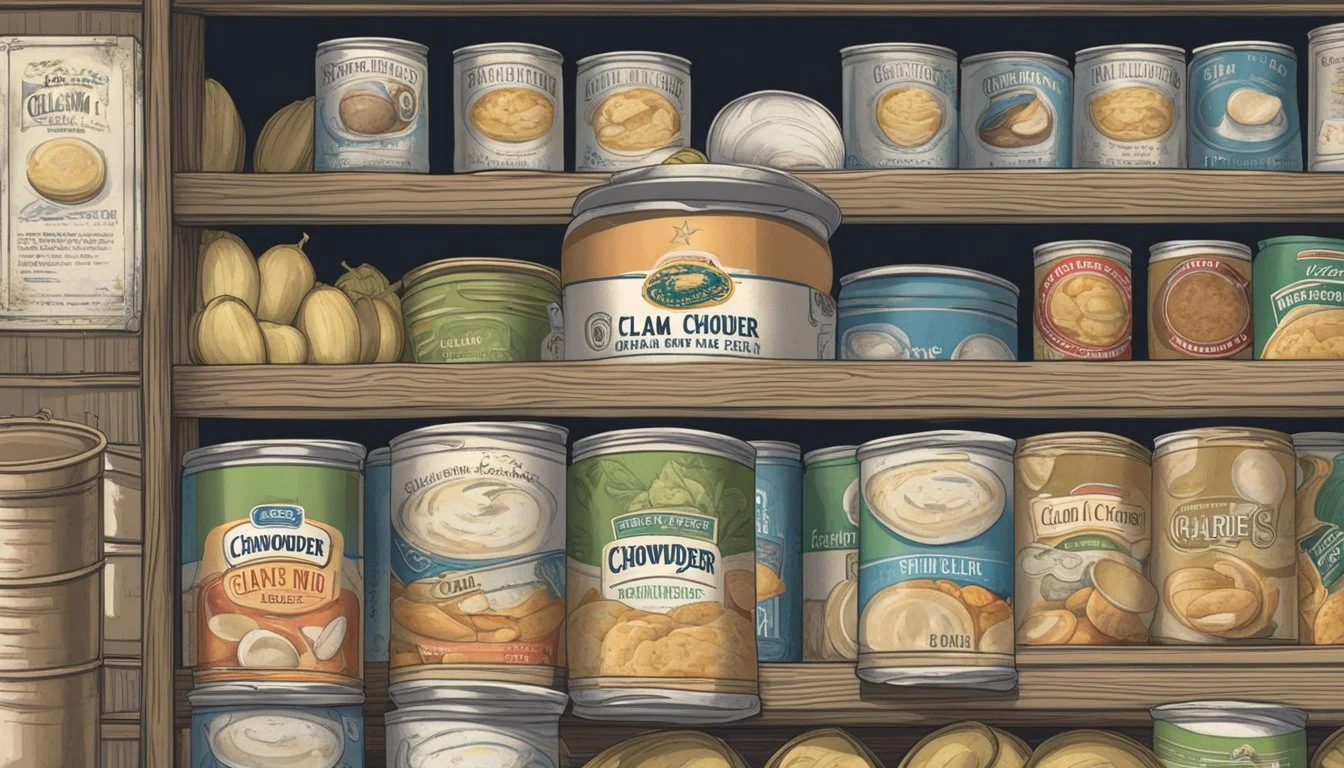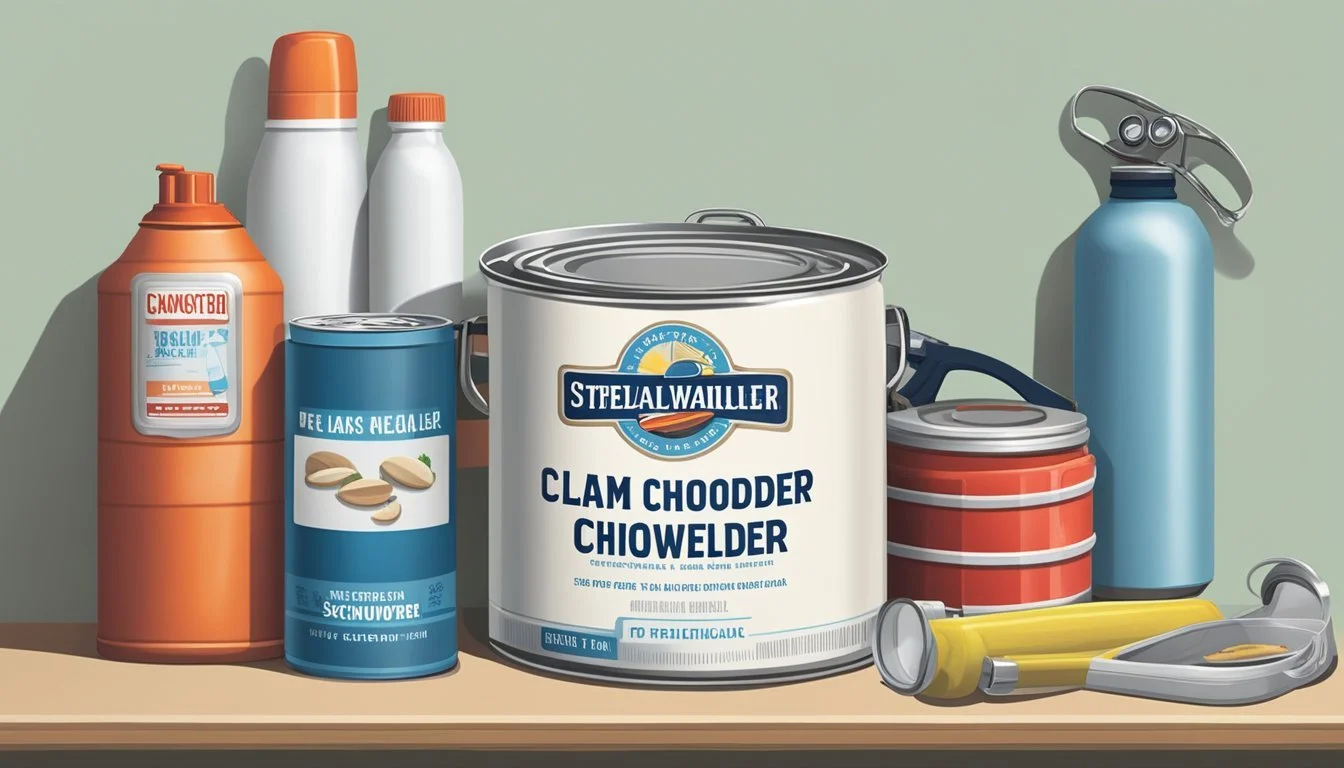Does Canned Clam Chowder Go Bad?
Shelf Life and Storage Tips
Canned clam chowder is a convenient pantry staple, but many wonder if it ever goes bad. Unopened canned clam chowder can last up to 2-5 years if stored in a cool, dry place. This long shelf life is achievable due to the canning process, which preserves the food by sealing it off from contaminants.
Once opened, canned clam chowder has a much shorter lifespan. It should be refrigerated and consumed within 4-5 days. Bacteria can grow rapidly in opened food, leading to spoilage and potential health risks.
It's important to check for signs of spoilage, whether the can is opened or not. Mold, off odors, and changes in flavor or appearance indicate that the chowder should be discarded. If the can is leaking, rusting, bulging, or severely dented, it is best to err on the side of caution and throw it away.
Understanding Canned Clam Chowder
Canned clam chowder is a convenient and popular option for those who enjoy this classic dish. It comes in two primary styles New England Clam Chowder and Manhattan Clam Chowder.
New England Clam Chowder is typically made with a cream base, giving it a rich and creamy texture. It often contains chunky potatoes, clams, and various veggies like celery and onions.
Manhattan Clam Chowder, on the other hand, features a tomato-based broth. This variety includes clams, veggies, and sometimes even a bit of spice, offering a lighter alternative to its New England counterpart.
Ingredients
The primary ingredients in canned clam chowder often include:
Clams: The main protein source, providing a distinct seafood flavor.
Cream or tomato: Depending on the type, these ingredients form the base of the chowder.
Chunky potatoes: Added for texture and substance.
Veggies: Commonly celery, carrots, and onions.
Shelf Life and Storage
Unopened canned clam chowder can last between 2 to 5 years if stored correctly. It should be kept in a cool, dry place away from direct sunlight to maximize its shelf life.
Once opened, it must be refrigerated and consumed within 4-5 days to ensure safety and freshness. Proper sealing and storage in an airtight container help maintain its quality.
The Importance of Storage
Proper storage of canned clam chowder is crucial for maintaining its quality and safety. By following specific storage conditions and using suitable containers, consumers can maximize the shelf life of their canned chowder and prevent spoilage.
Proper Storage Conditions
Storage is essential to maintain the quality of unopened canned clam chowder.
A cool, dry area such as a pantry or cupboard is ideal. The environment should be free from excessive humidity and away from direct sunlight.
Avoid placing cans near the stove, dishwasher, or any heat-emitting appliances. These conditions can accelerate degradation. Additionally, minimizing temperature fluctuations helps in preserving the contents of the can for the 3-5 years it remains optimal.
Ideal Temperature for Preservation
Temperature control is key in food storage, particularly for canned goods.
Canned clam chowder should be kept at room temperature, ideally between 50°F and 70°F (10°C and 21°C). Exposing canned products to higher temperatures can hasten spoilage and affect the flavor and texture of the chowder.
In environments prone to higher temperatures, consider keeping the chowder in a cooler spot, such as a basement or a temperature-regulated pantry, to maintain its integrity longer.
Airtight Container Usage
After opening, the storage method changes significantly. The clam chowder should be transferred into an airtight container.
Refrigeration is necessary, and it should be kept at 40°F (4°C) or below. Airtight containers help prevent contamination and reduce the chowder's exposure to air, which can compromise its quality.
In terms of longevity, opened clam chowder lasts about 4-5 days in the fridge. Proper sealing and refrigerated storage help maintain the safety and palatability of the chowder during this period.
Shelf Life and Expiration
Canned clam chowder can remain safe and retain its quality for a considerable period if stored correctly. Understanding the distinction between dated labels and the specifics of opened versus unopened cans is crucial.
Decoding Expiration Labels
Canned food often features various labels like “best by”, “best if used by”, “best before”, and “best when used by”. These dates are not safety dates but indicate the time during which the product is expected to be at its peak quality.
For canned clam chowder, it is typically safe to consume beyond these dates if the can is undamaged and stored properly. Expiration dates marked on cans are more of a guideline for quality rather than a strict safety indication.
However, if a can shows signs of bulging, rust, or leakage, it should not be consumed regardless of the date.
Shelf Life of Opened vs. Unopened Cans
Unopened cans of clam chowder can last between 3 to 5 years when stored in a cool, dry, and dark place. Proper storage helps in maintaining the quality, ensuring that the chowder remains safe to consume even past its peak quality date.
Opened canned clam chowder, on the other hand, has a much shorter shelf life. Once opened, it should be transferred to an airtight container and refrigerated at or below 40°F. Under these conditions, it will typically stay good for 3 to 4 days.
If frozen at 0°F or below, opened chowder can last for several months, though some change in texture and flavor may occur. Properly managing storage of both opened and unopened cans is key to enjoying safe and tasty clam chowder.
Recognizing Spoilage
Determining whether canned clam chowder has gone bad involves checking several factors. These include visual indicators, changes in texture and smell, and differences in taste and flavor.
Visual Inspection
Appearance is often the first clue. Look for mold, which appears as green, black, or white spots. A bulging can indicates gas produced by microbes, suggesting spoilage. Leaking or rusting cans should be discarded immediately, as they compromise food safety. The color of the chowder may also change, appearing darker or more discolored than usual if spoiled.
Assessing Texture and Smell
Upon opening, take note of the texture. Spoiled chowder might become overly thick or have separated layers. An off odor is a significant indicator; fresh clam chowder should smell briny and savory. If it emits a sour, metallic, or otherwise unpleasant smell, it has likely gone bad and should not be consumed to avoid food poisoning.
Taste and Flavor Analysis
Lastly, if the chowder passes the initial checks, a small taste test can confirm its condition. A change in flavor, such as increased sourness, bitterness, or an unusual taste, can indicate spoilage. If it doesn’t taste as expected, it’s safer to discard it to prevent any health risks. Always remember that the safety of food is more crucial than waste concerns.
Safety Measures
Proper handling and storage of canned clam chowder are crucial to prevent food-related illnesses. Identifying damaged cans and understanding the potential risks associated with consuming spoiled chowder are essential for maintaining food safety.
Handling Damaged Cans
Damaged cans can compromise the safety of canned clam chowder. Cans that are severely dented, bulging, rusting, or leaking should be discarded immediately. Severe dents may indicate that the can’s protective barrier has been breached, increasing the risk of contamination.
Commercially canned foods are designed to be airtight to block bacteria from entering. When a can is damaged, this seal might be broken, allowing bacteria and toxins to contaminate the food inside. Consumers should always inspect cans for any visible signs of damage before purchase and use.
Understanding Potential Risks
Once opened, canned clam chowder should be refrigerated and consumed within 4-5 days to minimize risk. Canned foods stored for extended periods can develop harmful levels of bacteria and toxins, particularly when food safety dates are ignored.
The protective barrier of the can, when intact, ensures a long shelf life—up to 2-5 years if stored in a cool, dry place. However, failing to store the cans properly or consuming the chowder past its safety date increases the risk of spoilage. Spoiled clam chowder may develop an off odor, flavor, or appearance, and should be disposed of immediately.
Extending Shelf Life
Proper storage can significantly extend the shelf life of canned clam chowder, ensuring it remains safe and enjoyable to eat for longer periods. Freezing, refrigeration, and careful handling of leftovers are key practices.
The Role of Freezing
Freezing canned clam chowder, especially if homemade, can help preserve it for up to three months.
Remove the chowder from the can and store it in airtight, freezer-safe containers. This prevents freezer burn and maintains texture and flavor.
Always leave some headspace in the container as the soup will expand when frozen.
When ready to eat, thaw in the refrigerator overnight before reheating. Avoid microwaving directly from frozen to prevent uneven heating.
After Opening: Refrigeration and Freezing
Once opened, store canned clam chowder in the fridge. It should be consumed within 4-5 days to maintain safety and taste.
Place the chowder in a tightly sealed container before refrigerating to prevent exposure to air, which can lead to spoilage.
If you plan to keep it longer, freezing is a good option. Use freezer-safe bags or containers, and label with the date to track how long it's been stored.
Properly reheated chowder can still offer close to its original taste and texture.
Maintaining Quality in Leftovers
Handling leftovers with care ensures they stay safe and tasty. Transfer leftovers to a clean, airtight container before putting them in the refrigerator to minimize bacterial growth.
Reheat leftovers gently on the stove or in the microwave, stirring occasionally. This helps maintain the best quality by preventing the clam chowder from becoming rubbery or losing its creamy consistency.
Discard any leftovers that have an off smell, appearance, or have been stored longer than recommended to avoid foodborne illness.
Following these steps helps maximize the shelf life and quality of canned clam chowder, keeping it a safe and delicious option in your pantry.
Additional Tips for Optimal Enjoyment
To fully appreciate canned clam chowder, consider the right serving techniques and creative ways to utilize any leftovers. Enhancing the taste and making the most of each serving can elevate this classic comfort food.
Serving Suggestions
For the best experience, heat the clam chowder slowly over low heat to prevent breaking or curdling. Stir occasionally to ensure even heating.
Adding fresh ingredients like chopped parsley, green onions, or a squeeze of lemon juice can brighten the dish.
Serving it with a side of toasted sourdough bread or a sprinkle of black pepper enhances the flavor and adds texture.
If desired, top with a drizzle of hot sauce for added heat. These small touches can transform a simple can of soup into a satisfying meal.
Creative Uses for Leftover Clam Chowder
Leftover clam chowder can be more than just reheated soup. Use it as a rich base for a seafood pasta dish by mixing it with cooked pasta and additional seafood like shrimp or scallops.
For a cozy twist, create a clam chowder pot pie by placing the leftover soup in a baking dish, topping with pie crust, and baking until golden brown. This comfort food dish can be an easy weeknight meal.
Additionally, using clam chowder as a filling for savory crepes or as a topping for baked potatoes can provide a unique and hearty meal. These ideas help minimize waste and maximize enjoyment from each can of clam chowder.







